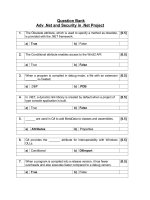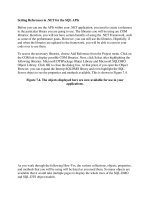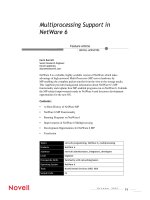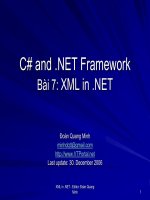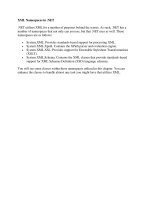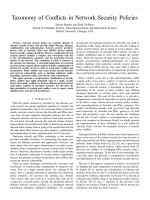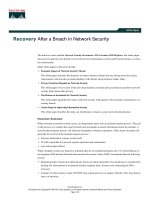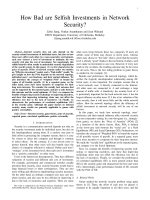aop in .net
Bạn đang xem bản rút gọn của tài liệu. Xem và tải ngay bản đầy đủ của tài liệu tại đây (8.8 MB, 298 trang )
MANNING
Matthew D. Groves
FOREWORD BY Phil Haack
Practical Aspect-Oriented Programming
www.it-ebooks.info
AOP in .NET
www.it-ebooks.info
www.it-ebooks.info
AOP in .NET
PRACTICAL ASPECT-ORIENTED
PROGRAMMING
MATTHEW D. GROVES
MANNING
SHELTER ISLAND
www.it-ebooks.info
For online information and ordering of this and other Manning books, please visit
www.manning.com. The publisher offers discounts on this book when ordered in quantity.
For more information, please contact
Special Sales Department
Manning Publications Co.
20 Baldwin Road
PO Box 261
Shelter Island, NY 11964
Email:
©2013 by Manning Publications Co. All rights reserved.
No part of this publication may be reproduced, stored in a retrieval system, or transmitted, in
any form or by means electronic, mechanical, photocopying, or otherwise, without prior written
permission of the publisher.
Many of the designations used by manufacturers and sellers to distinguish their products are
claimed as trademarks. Where those designations appear in the book, and Manning
Publications was aware of a trademark claim, the designations have been printed in initial caps
or all caps.
Recognizing the importance of preserving what has been written, it is Manning’s policy to have
the books we publish printed on acid-free paper, and we exert our best efforts to that end.
Recognizing also our responsibility to conserve the resources of our planet, Manning books
are printed on paper that is at least 15 percent recycled and processed without the use of
elemental chlorine.
Manning Publications Co. Development editors: Frank Pohlmann, Cynthia Kane
20 Baldwin Road Technical proofreader: Javier Lozano
PO Box 261 Copyeditor: Nancy Kotary
Shelter Island, NY 11964 Proofreader: Elizabeth Martin
Typesetter: Dottie Marsico
Cover designer: Marija Tudor
ISBN 9781617291142
Printed in the United States of America
1 2 3 4 5 6 7 8 9 10 – MAL – 18 17 16 15 14 13
www.it-ebooks.info
To my children Matthew and Emma
I will never grow tired of your yelling, “Daddy, Daddy!”
and tackling me when you hear the creak of my office door.
www.it-ebooks.info
www.it-ebooks.info
vii
brief contents
PART 1 GETTING STARTED WITH AOP 1
1
■
Introducing AOP 3
2
■
Acme Car Rental 21
PART 2 THE FUNDAMENTALSOF AOP 53
3
■
Call this instead: intercepting methods 55
4
■
Before and after: boundary aspects 79
5
■
Get this instead: intercepting locations 115
6
■
Unit testing aspects 141
PART 3 ADVANCED AOP CONCEPTS . 169
7
■
AOP implementation types 171
8
■
Using AOP as an architectural tool 191
9
■
Aspect composition: example and execution 213
www.it-ebooks.info
www.it-ebooks.info
ix
contents
foreword xiii
preface xv
acknowledgments xvii
about this book xix
PART 1 GETTING STARTED WITH AOP 1
1
Introducing AOP 3
1.1 What is AOP? 4
Features 4
■
Benefits 8
■
AOP in your daily life 13
1.2 Hello, World 14
1.3 Summary 19
2
Acme Car Rental 21
2.1 Start a new project 22
Business requirements 23
■
Necessary nonfunctional
requirements 24
2.2 Life without AOP 24
Write the business logic 25
■
Testing the business logic 28
Add logging 29
■
Introducing defensive programming 31
Working with transactions and retries 32
■
Handling
exceptions 35
■
Refactor without AOP 38
www.it-ebooks.info
CONTENTSx
2.3 The cost of change 43
Requirements will change 43
■
Small versus large projects 43
Signature changes 44
■
Working on a team 45
2.4 Refactor with AOP 45
Start simple and isolate the logging 45
■
Refactor defensive
programming 47
■
Creating an aspect for transactions and
retries 49
■
Put exception handling into its own class 50
2.5 Summary 52
PART 2 THE FUNDAMENTALSOF AOP 53
3
Call this instead: intercepting methods 55
3.1 Method interception 56
PostSharp method interception 57
■
Castle DynamicProxy
method interception 60
3.2 Real-world example: data transactions 63
Ensuring data integrity with begin and commit 63
When transactions go bad: rollback 67
■
When all
else fails, retry 67
3.3 Real-world example: threading 70
The basics of .NET threading 70
■
UI threads and worker
threads 71
■
Declarative threading with AOP 74
3.4 Summary 77
4
Before and after: boundary aspects 79
4.1 Boundary aspects 80
PostSharp method bounding 80
■
Method boundaries
versus method interception 83
■
ASP.NET HttpModule
bounding 88
4.2 Real-world example: detecting mobile users 92
Offer a link to an application 93
■
Don’t be a pest 99
4.3 Real-world example: caching 100
ASP.NET Cache 102
■
An application that could benefit
from caching 103
■
Caching a result 108
■
Retrieving
from the cache 110
■
A more robust cache key 113
4.4 Summary 114
www.it-ebooks.info
CONTENTS xi
5
Get this instead: intercepting locations 115
5.1 Location interception 116
Fields and properties in .NET 116
■
PostSharp location
interception 118
5.2 Real-world example: lazy loading 119
Lazy loading approaches in .NET 120
■
Implementing lazy
loading with AOP 121
■
What about lazy-loading fields? 124
5.3 Real-world example: INotifyPropertyChanged 128
Using INotifyPropertyChanged in a desktop application 128
Problems and constraints with INotifyPropertyChanged 132
Reducing boilerplate with AOP 134
5.4 Summary 138
6
Unit testing aspects 141
6.1 Writing tests with NUnit 142
Writing and running NUnit tests 142
■
Testing strategies
for aspects 145
6.2 Castle DynamicProxy testing 147
Testing an interceptor 147
■
Injecting dependencies 149
6.3 PostSharp testing 156
Unit testing a PostSharp aspect 157
■
Injecting
dependencies 158
■
Problems with PostSharp and testing 162
6.4 Summary 168
PART 3 ADVANCED AOP CONCEPTS 169
7
AOP implementation types 171
7.1 How does AOP work? 172
7.2 Runtime weaving 172
Proxy pattern revisited 173
■
Dynamic proxies 176
7.3 Compile-time weaving 183
Postcompiling 184
■
Before and after 184
7.4 Runtime versus compile-time weaving 188
Pros of runtime weaving 189
■
Pros of compile-time
weaving 189
7.5 Summary 190
www.it-ebooks.info
CONTENTSxii
8
Using AOP as an architectural tool 191
8.1 Compile-time initialization and validation 192
Initializing at compile time 193
■
Validating the correct use of
an aspect 195
■
Real-world example: Threading revisited 197
8.2 Architectural constraints 199
Enforcing architecture 200
■
Real-world example:
NHibernate and virtual 203
8.3 Multicasting 205
At the class level 206
■
At the assembly level 210
8.4 Summary 211
9
Aspect composition: example and execution 213
9.1 Using multiple aspects 214
9.2 Aspect roles with PostSharp 215
PostSharp aspect roles 217
■
Role dependencies 217
9.3 Composing aspects with DynamicProxy 219
Ordering aspects 219
■
Reducing repetition with custom
conventions 222
9.4 Real-world example: caching and authorization 224
Application architecture 225
■
PostSharp 232
Castle DynamicProxy 236
9.5 Summary 241
appendix A Ecosystem of .NET AOP tools 243
appendix B NuGet basics 257
index 265
www.it-ebooks.info
xiii
foreword
Like many great advances in our industry, the explicit concept of aspect-oriented pro-
gramming (AOP) was developed at what is now known as PARC, a Xerox Company.
Soon after, in 2001, the AspectJ extensions brought AOP to Java. Aspects have enjoyed
a long history in the Java community, but for many .NET developers, aspects are still
considered new and exotic. Even so, many .NET developers have been using them
without knowing it.
Aspects provide a means of separating cross-cutting concerns from your core
implementation code into separate modules. Rather than having every method con-
tain logging code, for example, a logging aspect can be applied to methods external
to the method implementation. It’s a powerful technique to help employ the princi-
ple of separation of concerns within code.
In AOP in .NET, Matthew D. Groves deftly shines a light on the many ways develop-
ers can take advantage of aspects in .NET. He begins with an approachable introduc-
tion to AOP and builds on that with an example of an application written without
aspects, which is then cleaned up with aspects. Subsequent chapters dig deeper into
the various types of aspects and how to apply them using PostSharp and Castle
DynamicProxy.
Each chapter builds on the previous one in a distinct, understandable style, each
with sample code that clarifies the concepts covered in the chapter. Great care was
obviously put into the code samples.
One example in particular shows how aspects are not limited to intermediate lan-
guage (IL) rewriting and method interception. He challenges this implicit assump-
tion by showing an aspect that wraps an HTTP request boundary in ASP.NET through
www.it-ebooks.info
FOREWORDxiv
a custom
HttpModule
implementation. It’s an example that might not, at first glance,
be thought of as an aspect. But on reflection, it obviously meets the definition. Aspects
are not limited to compile-time interception. This drives home the point that many
developers have been using aspects of one form or another for a long time without
realizing it.
One subject near and dear to me is unit testing and this book contains an entire
chapter covering the implications of unit testing and how to unit test aspects. It’s clear
this book is not just meant to educate the reader on a subject, but to help the reader
integrate the techniques and technologies with real-world practices.
AOP in .NET is a great resource for those interested in learning how aspects can
help maintain separation of concerns in a code base. I encourage you to take a look.
PHIL HAACK
DEVELOPER, GITHUB
www.it-ebooks.info
xv
preface
A few years ago I was working on a team of consultants embedded in an organization
(that shall remain unnamed). Our job was to create a system that would help increase
a key source of revenue. This organization’s IT department had many problems:
political, technical, organizational, and financial. As consultants, we, naturally,
wanted to overhaul everything immediately to solve these problems, but the reality of
consulting is that we had to take very slow, very small steps toward the goal. In the
meantime, we had to work around the technical and organizational problems in
order to help solve the financial ones, and that’s how I first learned about aspect-ori-
ented programming (AOP).
We were creating a website for the public to submit registration information and
pay fees. One of the constraints we faced when writing this system was the enterprise
database. We had to access the enterprise data via an unreliable and error-prone ser-
vice that was meant to act as this organization’s SOA (service-oriented architecture).
There were some good ideas in this service, but the implementation was poor: some-
times as many as half the requests to this system would result in an exception, seem-
ingly at random. After considerable testing and tinkering, we discovered that simply
retrying the identical request once or twice would result in a successful request.
Because of this, we didn’t want to use this buggy, unproven SOA service, but at that
point we didn’t have a choice.
We needed to create a reliable website that would be able to function with an unre-
liable layer of data persistence and enterprise services. What we built was a piece of
code that would begin a transaction, try a request, catch exceptions of a certain type,
and retry the request until it succeeded, or roll it back if it didn’t. If it didn’t succeed,
www.it-ebooks.info
PREFACExvi
it would log the exception type, the exception message, and some related information
about the request. With this log, we hoped to first, build evidence that we could use to
prove how unreliable this SOA service was, and second, be able to match exceptions
with any customer-reported technical issues. What we built was a critical transaction
helper class that was used over and over every time we needed to use the SOA service.
This leads me to one of the organizational problems: the QA department was
responsible for testing our application, but QA was notorious for being overworked
and/or unreliable. This meant that they might not get around to reporting a bug that
they found in our project until possibly two weeks later, or more. If one of us on the
team accidentally forgot to use our transaction helper class when accessing the SOA
service (or when someone new to the team was unaware of this helper class), then we
might not find out for weeks, even if QA was (un)lucky enough to get one of the ran-
dom exceptions.
I was pulling my hair out: surely there was a way to refactor this nonfunctional
requirement so we didn’t have to worry about forgetting it. Plus, it was getting tangled
up with the rest of our code, making it harder to read and maintain.
By chance, I was attending a .NET conference in Ohio, and Michael Kramer, an
acquaintance of mine, was giving an introductory talk on AOP using PostSharp. He
showed basic 101-level examples, similar to the ones you’ll see early in this book. The
idea of being able to write a piece of code that would be in class A yet run somewhere
else (say, before and after the methods in class B) was astounding to me, and I men-
tally checked out of the rest of the conference and immediately started thinking of
ways to apply AOP to the transaction helper class problem.
Fast-forward to now, and I’m still using AOP to solve similar problems (although I
left that organization and the consulting business altogether). I started speaking at
software conferences about AOP, started blogging about AOP, and became something
of a community advocate for AOP. I was often asked if I could recommend a book on
the topic for .NET developers, and I really couldn’t. I eventually decided that this book
had to be written. So that’s what you have here, a book on a topic about which I am
very passionate—not only because it’s a powerful and useful tool when used properly,
but because it helped me out in a very tough situation.
www.it-ebooks.info
xvii
acknowledgments
There are so many people who have influenced my career and experience, and thus
this book. Everyone on Twitter whom I follow, everyone I’ve worked with, all the
attendees and speakers that I meet at user groups and conferences. Even if it’s a small
thing like teaching me a keyboard shortcut, I owe you a debt of gratitude.
I’d like to specifically acknowledge:
Nick Chase, Frank Pohlmann, Cynthia Kane, Michael Stephens, Bert Bates, Eliza-
beth Martin, Mary Piergies, and everyone else at Manning. Thank you for your guid-
ance and help, and for getting this ship into the water.
Seth Petry-Johnson, Jonathan Hammond, Jesse Riley, David Giard, Charles Huse-
mann, Brady Gaster, Chris Farrell, Jim Christopher, Steve Horn, H. Alan Stevens,
Jason Follas, Brian Watson, Richard Dudley, Jay Harris, James Bender, Steve Fischer,
John Dages, Brian Prince. I could fill a book with all the great people I’ve met on my
career’s journey. If I forgot to include you, I’m sorry; I owe you lunch.
Dan Allen, for giving me my first programming job.
Michael Kramer, for that fateful day when he unwittingly unleashed AOP into
my life.
Everyone I’ve worked with at OSU, Quick Solutions, and Telligent.
Xiaoran Wang, for the tremendous diagrams (explaining tangling, scattering, and
weaving) that he was kind enough to let me use in this book.
Vince Fabro, for being an inspiring, patient leader in tough times, and Jonathan
Mitchem for making our time in the foxholes more educational and entertaining
than I ever expected.
Jason Gilmore, for your guidance and all you do for the developer community.
www.it-ebooks.info
ACKNOWLEDGMENTSxviii
Ben Maddox, whose honesty and integrity are like gold.
Mark Greenway, for being an amazingly smart and helpful guy, and naming the guy
on the book cover the “Archduke of Programmerland.”
Gael Fraiteur and Britt King, for working so hard on your product and for encour-
aging and supporting me. Donald Belcham, Dustin Davis, Joe Kuemerle, Chad Eng-
land, the rest of the PostSharp MVPs, and all community advocates for aspect-oriented
programming.
Craig McKeachie, for giving me really good advice.
Bill Sempf, for being an inspiration and a mentor.
Phil Haack, for being gracious enough to write the foreword, not to mention his
long list of incredible contributions to the .NET community.
Jim Holmes, a selfless (albeit poorly dressed) legend who spreads joy and awesome-
ness wherever he treads.
Jon Plante, for playing video games with me during a terribly difficult time in my
life. I have been, and always shall be, your friend.
Javier Lozano, for his careful technical review of the final manuscript and source
code shortly before the start of production.
My reviewers, who read the manuscript several times during its development and
provided invaluable feedback: Aaron Colcord, Heather Campbell, Jeremy Baker, Jona-
than Clark, Koen Handekyn, Maarten Balliauw, Margriet Bruggeman, Mark Bell-
house, Mark Greenway, Mick Wilson, Nikander Bruggeman, Paul Stack, Phil Haack,
Pim Van Oerle, Stuart Grassie, and Toby Moore.
My entire family, specifically, my parents Kevin and Mary, for always encouraging
me, even when my greatest aspiration as a seven-year-old was to be a garbage collector
(ironic, considering that I now write managed code). If you don’t make it through the
first chapter without being bored to tears, I completely understand, and I love you
anyway. And Dad, thanks for teaching me BASIC on a TRS-80 all those years ago.
And of course, my wife Ali, who encourages me, puts my needs above her own, and
has given me the gifts that keep on giving: our children. I love you.
www.it-ebooks.info
xix
about this book
Aspect-oriented programming (AOP) is a concept that is too often surrounded by
dense language and academic terminology, which can make it difficult for a working
developer—who is already short on time and struggling to meet deadlines—to under-
stand, apply, and get value from AOP quickly. It’s unfortunate, because at its core, AOP
is much less difficult than it sounds and can provide immediate benefits to real-world
projects.
My goal has been to write the book that I wish I had read years ago and to show that
AOP is much easier done than said. To that end, this book is somewhat informal in
tone and short on theory, and it contains lots of code samples, with which I hope you
follow along.
As much as I want this book to take a generalized approach to AOP, in order to show
you real aspects I have to use real tools. I have chosen PostSharp (specifically, the free
version, PostSharp Express edition) as the primary framework that I will be using most
often. Castle DynamicProxy examples are also used frequently. I also discuss some of
the advanced features of the paid version of PostSharp, and other tools and frame-
works will be used and discussed in the course of the book, as well as in appendix A.
Roadmap
Chapter 1 introduces AOP. It covers some of the features and terms that are used in
AOP. You will also write a “Hello, World” aspect.
Chapter 2 is a complete project tutorial. You will start a new project, implement fea-
tures, add cross-cutting concerns, and then refactor it using AOP.
www.it-ebooks.info
ABOUT THIS BOOKxx
Chapters 3, 4, and 5 cover different types of aspects in more detail, with real-world
examples for each.
Chapter 6 discusses the impact that AOP has on unit testing. You’ll learn how to
write unit tests for aspects and write unit tests for code on which aspects are used.
Chapter 7 discusses the implementation details of how AOP tools work. You have a
choice of weaving style that will dictate both the capabilities and the trade-offs
involved in the two major categories of AOP tools.
Chapter 8 covers some of the architectural concerns involved in using AOP, as well
as the architectural abilties that it can give you.
Chapter 9 explores what happens when you need to use multiple aspects on the
same piece of code. This chapter’s real-world example also provides a capstone exam-
ple that shows many of the concepts from chapters 1 through 8 working in concert.
Appendix A describes the ecosystem of .NET AOP tools, including both compile-
time and runtime tools. Appendix B covers NuGet basics.
Who should read this book?
This book is primarily for developers and architects looking to reduce repetition and
boilerplate in their projects. Generally speaking, the type of developer who will get
the most out of this book is a developer faced with large projects that can have a lot of
repetition and boilerplate. Small or tiny projects can still benefit from AOP—just not
as much.
This book assumes that you have a working knowledge of C# and .NET. I also
assume some familiarity with design patterns, architecture, and inversion of control.
The nature of cross-cutting concerns means that AOP is involved with multiple areas
of focus, including UI, databases, caching tools, threading frameworks, and so on.
When possible, I try to give as much context as I reasonably can without going too far
into a rabbit-hole of subject matter that has been covered more completely by other
books.
Code conventions and downloads
This book includes many examples involving AOP. Most often, these examples are in
C#, but sometimes they use other languages such as HTML, XAML, or plain XML.
Source code in listings, or in text, is in a
fixed-width font like this
to separate it
from ordinary text. Whenever C# class names, method names, variables, and other
elements are mentioned in text, they will also be displayed in a fixed-width font. Code
annotations accompany many of the code listings, highlighting important concepts.
Some of the examples are long. Often they have been reformatted with indentation
and line breaks to fit in the space allotted in this book. The full source code is avail-
able for you on GitHub ( and from the
publisher’s website at www.manning.com/AOPin.NET. The instructions to use the
samples in this book are mentioned briefly in the chapters, and more details about
NuGet are available in appendix B.
www.it-ebooks.info
ABOUT THIS BOOK xxi
Author Online
The purchase of AOP in .NET includes free access to a private web forum run by Man-
ning Publications where you can make comments about the book, ask technical ques-
tions, and receive help from the author and other users. To access the forum and
subscribe to it, visit This page provides informa-
tion on how to get on the forum once you are registered, what kind of help is avail-
able, and the rules of conduct on the forum.
Manning’s commitment to our readers is to provide a venue where a meaningful
dialogue between individual readers and between readers and the author can take
place. It is not a commitment to any specific amount of participation on the part of
the author, whose contribution to the forum remains voluntary (and unpaid). Let
your voice be heard, and keep the author on his toes!
The Author Online forum and the archives of previous discussions will be accessi-
ble from the publisher’s website as long as the book is in print.
About the author
MATTHEW D. GROVES is a guy who loves to code. It doesn’t matter if it’s “enterprisey”
C# apps, cool jQuery stuff, contributing to OSS, or rolling up his sleeves to dig into
some PHP. He has been coding professionally ever since he wrote a QuickBASIC
point-of-sale app for his parents’ pizza shop back in the 1990s. He currently works
from home in Columbus, Ohio, on the Telligent product team. He loves spending
time with his wife and two children, watching the Cincinnati Reds, and getting
involved in the developer community. He also teaches at Capital University in Colum-
bus, Ohio.
You can find Matthew’s blog at . Trade insults,
horse jokes, and funny cat pictures with him on Twitter at />mgroves.
About the cover illustration
The figure on the cover of AOP in .NET is captioned a “Farmer from Kastela, Dalmatia,
Croatia.” The illustration is taken from the reproduction published in 2006 of a 19th-
century collection of costumes and ethnographic descriptions entitled Dalmatia by
Professor Frane Carrara (1812-1854), an archaeologist and historian, and the first
director of the Museum of Antiquity in Split, Croatia. The illustrations were obtained
from a helpful librarian at the Ethnographic Museum (formerly the Museum of
Antiquity), itself situated in the Roman core of the medieval center of Split: the ruins
of Emperor Diocletian’s retirement palace from around AD 304. The book includes
finely colored illustrations of figures from different regions of Croatia, accompanied
by descriptions of the costumes and of everyday life.
Once an ancient Greek port, a stopover point for Roman soldiers and a summer
place for Croatian kings, Kastela is today a popular tourist resort on the Adriatic coast.
Along its long sandy beaches there are terraces and lookouts, tennis courts and other
sports grounds, and hotels and villas, surrounded by the lush greenery of pine and
www.it-ebooks.info
ABOUT THIS BOOKxxii
tamaris trees. The man on the cover, clearly a prosperous farmer from the region, is
wearing black woolen trousers and a red vest over a white linen shirt. On his shoulders
is a fur cape, and a red belt, red cap, and red socks complete the outfit; in his hand he
holds a satchel. The rich and colorful embroidery on his costume is typical for this
region of Croatia.
Dress codes have changed since the 19th century and the diversity by region, so
rich at the time, has faded away. It is now hard to tell apart the inhabitants of different
continents, let alone different towns or regions. Perhaps we have traded cultural diver-
sity for a more varied personal life—certainly for a more varied and fast-paced techno-
logical life.
At a time when it is hard to tell one computer book from another, Manning cele-
brates the inventiveness and initiative of the computer business with book covers
based on the rich diversity of regional life of two centuries ago, brought back to life by
illustrations from collections such as this one.
www.it-ebooks.info
Part 1
Getting started with AOP
Aspect-oriented programming sounds complicated, but it really isn’t. It
helps you spend less time copying and pasting the same boilerplate code, reduc-
ing repetition, and gives you more time to add value to your project.
Chapter 1 introduces you to AOP, its history and what problems it was created
to solve. You’ll write a “Hello, World” aspect using PostSharp as your first project.
Chapter 2 is a crash course in using AOP. You’ll code the business logic for
Acme Car Rental Company, add cross-cutting concerns without AOP, and then
explore refactoring it to use AOP.
www.it-ebooks.info
www.it-ebooks.info
